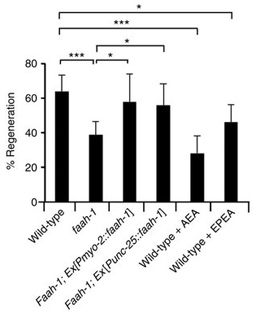Research Abstract
線虫では内在性カンナビノイド-Goαシグナル伝達はGqα-PKC-JNKシグナル伝達と拮抗することにより軸索再生を阻害する
Endocannabinoid-Goα signalling inhibits axon regeneration in Caenorhabditis elegans by antagonizing Gqα-PKC-JNK signalling
2012年10月16日 Nature Communications 3 : 1136 doi: 10.1038/ncomms2136

神経細胞が傷ついた軸索を再生する能力は、再生を促進する細胞経路と阻害する細胞経路の間のバランスによって決まる。線虫(Caenorhabditis elegans)では、軸索再生はJNK(c-Jun N末端キナーゼ)MAPキナーゼ経路によってまさに制御されており、さらにこの経路は増殖因子-受容体チロシンキナーゼシグナルによって活性化される。本論文では、内在性カンナビノイドであるアナンダミド(アラキドノイルエタノールアミド)の分解酵素として働く脂肪酸アミドヒドロラーゼ1が、レーザー軸索切断後のGABA(γ-アミノ酪酸)ニューロンでの軸索再生応答を制御していることを明らかにする。外部から投与したアナンダミドは、GoαのサブユニットであるGOA-1を介して、GqαサブユニットであるEGL-30と拮抗することにより軸索再生を阻害する。Gqαの下流では、プロテインキナーゼCが機能しており、これがMLK-1をリン酸化することにより、MLK-1-MEK-1-KGB-1からなるJNK経路を活性化する。今回の結果は、アナンダミドによるGタンパク質シグナル伝達経路の誘導が、発生期終了後の軸索再生を阻害する役割を持つことを示唆している。
Strahil Iv. Pastuhov1, 藤木 恒太1, Paola Nix2, 金尾 朱夏1, Michael Bastiani2, 松本 邦弘1 & 久本 直毅1
- 名古屋大学大学院 理学研究科
- ユタ大学(米国)
The ability of neurons to regenerate their axons after injury is determined by a balance between cellular pathways that promote and those that inhibit regeneration. In Caenorhabditis elegans, axon regeneration is positively regulated by the c-Jun N-terminal kinase mitogen activated protein kinase pathway, which is activated by growth factor-receptor tyrosine kinase signalling. Here we show that fatty acid amide hydrolase-1, an enzyme involved in the degradation of the endocannabinoid anandamide (arachidonoyl ethanolamide), regulates the axon regeneration response of γ-aminobutyric acid neurons after laser axotomy. Exogenous arachidonoyl ethanolamide inhibits axon regeneration via the Goα subunit GOA-1, which antagonizes the Gqα subunit EGL-30. We further demonstrate that protein kinase C functions downstream of Gqα and activates the MLK-1-MEK-1-KGB-1 c-Jun N-terminal kinase pathway by phosphorylating MLK-1. Our results show that arachidonoyl ethanolamide induction of a G protein signal transduction pathway has a role in the inhibition of post-development axon regeneration.

